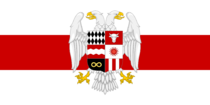Flag of Amathia
| Name | Ⰴⱃⰰⱂⰵⰾⱆⰾ Ⱄⰻⱀⰳⰵⰾⱆⰹ Drapelul Sângelui "The Flag of Blood" |
|---|---|
| Use | National flag and ensign |
| Proportion | 1:2 |
| Adopted | 10 May 1080 (according to legend) 1 December 1532 (first recorded variant) 1 December 1715 (original) 15 May 1980 (current) |
| Design | A horizontal triband of white, red, and white |
| Designed by | Celer Arvenul |
 Variant flag of Amathia | |
| Use | State and war flag |
| Proportion | 1:2 |
| Adopted | 15th of May, 1980 |
| Design | Flag with the coat of arms of the Amathian Democratic Republic |
| Designed by | Aurel Soron |
The national flag of the Amathian Democratic Republic (Amathian: Ⱄⱅⰵⰰⰳⱆⰾ Ⱃⰵⱂⱆⰱⰾⰹⱌⰹⰹ Ⰴⰵⰿⱁⱌⱃⰰⱅⰵ Ⰰⰿⰰⱅⱍⰹⰵⱀⰵ, tr. Steagul Republicii Democrate Amathiene), is a horizontal triband of white, red, and white, with a width-length ratio of 1:2, as specified in the Constitution of Amathia.
The Banner of Blood, as it is symbolically known, is, through its many iterations, one of the oldest flags in Euclea, variants of it having been used by the Empire of Arciluco, the Unio Trium Nationum, the Kingdom of Amathia and the Amathian Equalist Republic. The white-red-white triband has become associated with the very concept of the Amathian state itself, and the current variant of the flag was officially adopted in May 1980 by the Amathian Democratic Republic.
Design
| White | Red | |
|---|---|---|
| RAL | RAL 9016 | RAL 3020 |
| CMYK | 0, 0, 0, 0 | 0, 100, 100, 20 |
| RGB | (255, 255, 255) | (204, 0, 0) |
| HEX | #FFFFFF | #CC0000 |
History and significance of the colors
The origins of the flag can be traced back to the medieval coat of arms of the Cyriacan Dynasty. Red and white were the colors most commonly associated with the realm of Arciluco, but for most of its early history, Arciluco lacked proper heraldry - instead using holy icons or red banners with the Grapevine Cross in white. It was only after increased contact with Eastern Euclea that the Arcilucans started to adopt and to use proper heraldry, and the ruling House of Cyriacus adopted a red band on a silver field (in heraldry: Argent a fess Gules).
According to legend, after Eligiu the Holy died during the cavalry charge that saved Arciluco during its siege by Marolev tribes, some of his guards tried to take his body back behind the walls, and used a large white coat to cover him. When they arrived in the city and the body was taken to the cathedral, the large stain of blood on it roughly managed to form a band. Since another attack on the walls was still expected, Eligiu's successor, Prince Viatul, decided to use the bloody coat in order to mobilise the soldiers and the people by showcasing their Emperor's sacrifice, so the coat was hanged as a banner in one of the towers of the main gate. As the Marolevs abandoned the siege, and Eligiu was later on canonised, the improvised banner became a holy relic, and was kept in the Cathedral of the Apostles until it was looted in 1711, when it was lost.
Other flags currently in use
Historical Flags
Flag of the Empire of Arciluco (~500 - 1435)
Flag of the Unio Trium Nationum (1526-1711)
Flag of the Kingdom of Amathia (1729 1924), (1934-1940)
Flag of the Amurgist Amathia (1924-1934)
Flag of the Amathian Council Republic (1935-1959)
Flag of the Amathian Equalist Republic (1959-1979)
Flag of the Amathian Revolution (1979)









